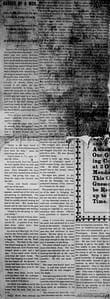
George Scott was an African American man born between 1873 and 1879. In 1898, he worked as a farm hand for William Scroggins 2.5 miles east of Adairville, Kentucky (a small town in southern Kentucky, bordering Tennessee). There is little extent information about Scott. Accounts of his life and his work have been drawn from newspapers at the time.
Based on newspapers’ conflicting accounts, on the morning of June 1 1898, Hattie Scroggins (William Scroggins’ wife) either accused Scott of making an “indecent proposal to her” or attempted assault. Following this incident, William Scroggins took a shotgun and chased Scott from the area, firing at him twice. These shots hit Scott in the back without serious injury. Scott escaped in the direction of Springfield, Tennessee, 12 miles south of Adairville. Late that afternoon, he was captured near Springfield and taken to jail there.
On the afternoon of June 2, Scott was moved to the jail in Russellville, Kentucky. According to The Nashville American, “[I]t had been explained to him that he would be much safer [in Russellville], as he could be shipped to Bowling Green or Louisville should a mob attempt to lynch him.” On June 3, The Nashville American stated that, “Scott denies the whole affair in toto,” however his claim of innocence was discounted by local white newspapers. On June 4, 1898 The Daily Kentuckian stated that the lynching of George Scott was probable.
Three weeks later, on midnight after June 25, an armed mob of 50 to 60 men presumably from Adairville came to the Russellville jail and demanded entrance. Jailer Price opened the door and gave the mob the keys to Scott’s cell. The Earlington Bee reported that the mob may have cut the phone or telegraph wires to the jail before it arrived. Scott was driven about a mile from the courthouse and then hanged on a cedar known as the “Proctor Tree,” and shot four times. This is the spot where two men had been hanged a year and a half before.
According to the Louisville Courier-Journal, “A few members of the mob were masked, but the majority were not disguised. The jailer failed to recognize any of them.” In an inquest the following morning, The Lexington Herald-Leader states, “[N]othing leading to the identification of any member of the mob was found out.” Following the lynching, no known actions were taken against the mob.
References
- “Lynched. By a Determined Mob Was George Scott, the Colored Assailant of a White Woman,” The Cincinnati Enquirer, June 27, 1898. Newspapers.com.
- “To A Tree. George Scott, Colored, Was Hanged By a Mob,” The Courier-Journal, June 27, 1898. Newspapers.com.
- “May Be A Hanging, Negro Brute Assaults a White Woman,” The Herald-Ledger, June 3, 1898. Newspapers.com.
- “Hanged By A Mob, Geo. Scott Answers for his Crime to Judge Lynch,” The Herald-Ledger, July 1, 1898. Newspapers.com.
- “Spirited Him Away,” The Tennessean, July 3, 1898. Newspapers.com.
- “Safe In Kentucky,” The Tennessean, July 5, 1898. Newspapers.com.
Location of the Lynching
Citation
Myrup, Annika. “George Scott.” Documented Biographies. Documenting Racial Violence in Kentucky. March 17, 2023. https://drvk.createuky.net/biographies/1891-1900/george-scott/








